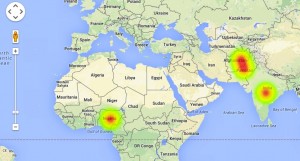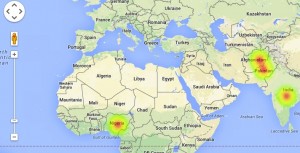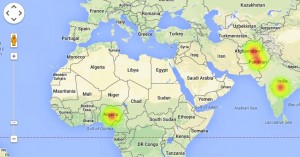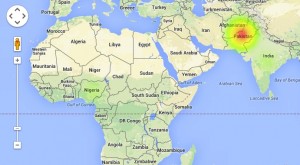The Fate of Poliomyelitis after Salk’s US Campaign
Brooke Bandon, Marie Videau and Mattie DeCella
History of Polio after Salk
1957: Start of the first oral poliovirus vaccination tests in the Democratic Republic of Congo
1961: Dr. Albert Sabin develops an oral vaccination, it rapidly becomes the vaccine of choice against polio.
1968: Salk’s vaccine was no longer routinely used in the US, until reappearance in 1997.
1970’s: Surveys show that polio is widespread in many developing countries, which leads to the routine immunization of polio.
1985: Rotary International launches PolioPlus.
1988: Global Polio Eradication Initiative is launched; vows to eradicate polio by year 2000.
1994: polio declared eliminated in the Americas.
1996: Nelson Mandela launches “Kick Polio Out of Africa campaign” leading to 420 million children in Africa being vaccinated.
2001: 35 million children in Afghanistan and Pakistan vaccinated.
2002: Polio eradicated from Europe.
2003: In Northern Nigeria, campaigns are suspended because of rumors about the safety of the vaccine. A new outbreak occurs.
2006: Four endemic countries remain: Afghanistan, India, Nigeria, and Pakistan. Outbreaks ended in Yemen and Indonesia.
2009: New bivalent oral poliovirus vaccine used in Afghanistan.
2011: People stop getting vaccinations because of the CIA going in and claiming to be giving vaccinations when they were not.
2014: South-East Asia region declared polio free.
Polio Eradication and Endgame Strategic Plan 2013-2018
A plan was developed by the Global Polio Eradication Initiative (GPEI) with the help of national health authorities, scientific experts, donors, and other global health initiative in response to the World Health Assembly. The polio eradication and endgame plan addresses the eradication of all polio disease while planning for the backbone of the polio effort to be used for delivering other health services to children. They even set up an Emergency Action Plan to be used.
State the Facts
- Polio cases have decreased by over 99% since 1988, from an estimated 350,000 cases in more than 125 endemic countries then, to 416 reported cases in 2013.
- These included only 160 cases in endemic countries; international spread from endemic areas into polio-free areas accounted for the remainder.
- In 2014, only 3 countries (Afghanistan, Nigeria and Pakistan) remain polio-endemic, down from more than 125 in 1988.
- In 2014, only parts of 3 countries in the world remain endemic for the disease–the smallest geographic area in history. Of the 3 strains of wild poliovirus (type 1, type 2, and type 3), wild poliovirus type 2 was eradicated in 1999 and case numbers of wild poliovirus type 3 are down to the lowest-ever levels with the no cases reported since November 2012 from Nigeria.
WPV v. cVDPV
WPV: wild poliovirus
cVDPV: circulating vaccine-derived poliovirus
- Occurs from a genetic mutation in the strain, rarely, and only in the right circumstances. (On rare occasions, if a population is seriously under-immunized, an excreted vaccine-virus can continue to circulate for an extended period of time. The longer it is allowed to survive, the more genetic changes it undergoes. In very rare instances, the vaccine-virus can genetically change into a form that can paralyse – this is what is known as a circulating vaccine-derived poliovirus (cVDPV). It takes a long time for a cVDPV to occur. Generally, the strain will have been allowed to circulate in an un- or under-immunized population for a period of at least 12 months. Circulating VDPVs occur when routine activities are poorly conducted and a population is left susceptible to poliovirus, whether from vaccine-derived or wild poliovirus. Hence, the problem is not with the vaccine itself, but low vaccination coverage. If a population is fully immunized, they will be protected against both vaccine-derived and wild polioviruses.)

India: 524
Nigeria: 1
Pakistan:215

India: 225
Nigeria: 335
Pakistan: 103

India: 1
Nigeria: 62
Pakistan: 198

India: 0
Nigeria: 0
Pakistan:21
Resources:
https://extranet.who.int/polis/public/CaseCount.aspx
http://www.polioeradication.org/Infectedcountries/Pakistan.aspx#sthash.4llgnOMd.dpuf
http://www.polioeradication.org/Portals/0/Document/InfectedCountries/Pakistan/2014_NEAP_Pakistan.pdf
http://www.polioeradication.org/Portals/0/Document/InfectedCountries/Afghanistan/AnnualReport_PEI_Afgh_2013.pdf
http://www.polioeradication.org/Infectedcountries/Nigeria.aspx
http://www.polioeradication.org/Portals/0/Document/InfectedCountries/Nigeria/Nigeria_NationalPolioEradicationEmergencyPlan_2014.pdf
http://www.who.int/mediacentre/news/releases/2013/polio_six_year_plan_20130425/en/
http://www.who.int/mediacentre/factsheets/fs114/en/